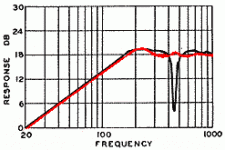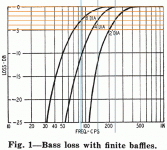After Olsen:
dave
An externally hosted image should be here but it was not working when we last tested it.
dave
dave,
Are you sure this graph is accurate? It is in dis-agreement with the one on the Melhuish site.
My baffles are about 36 inches wide and start rolling off between 80 Hz and 100 Hz, which is in agreement with the Melhuish graph. Acording to the one posted here, my baffles would need to be about 75 inches.
http://melhuish.org/audio/enclosurebaff.htm
Dave
Are you sure this graph is accurate? It is in dis-agreement with the one on the Melhuish site.
My baffles are about 36 inches wide and start rolling off between 80 Hz and 100 Hz, which is in agreement with the Melhuish graph. Acording to the one posted here, my baffles would need to be about 75 inches.
http://melhuish.org/audio/enclosurebaff.htm
Dave

hurdy_gurdyman said:Are you sure this graph is accurate? It is in dis-agreement with the one on the Melhuish site.
We actually had this discussion on th FR Froum too
The graph is according to Olsen (and for a square baffle) and the empirical results he gets back the above graph up. (the black is with the driver dead set in the middle of a 4 ft sqaure baffle, the red with the driver offset).
Alot of people suggest empirical results that indicate you can get away with a smaller baffle. I need to dig out the paper by Juha Backman where he estimates the roll-off based on actual driver position and baffle shape.
dave
Attachments
Although P10 knows an awful lot about speakers,
There is no doubt that his interpretation of Olsen shown above (post #3) disagrees with every other graph I've seen. Your experience is a useful piece of data. Was your baffle on the floor?
Another issue is how to average various distances to the edge of the baffle. If the baffle continues all the way to the floor than that side is a infinite baffle. I'm pretty sure that the soundwaves don't all "shortcircuit" over the shortest distance to the baffle edge.
I think Olsen's panels were suspended in the air and didn't go to the floor, which changes a LOT!!
This all needs to be confirmed, and unlike about everything else we discuss here, could be studied easily experimentally by someone with a saber saw! , a db meter, and a signal generator. and then we would know!
Maybe the 2 Daves shoud design some experiments!
Lets get our own empirical results and stop just reiterating papers
Dave P10: It looks like your results are about exactly double others? Maybe some confusion about a distance being the baffle width when it is actually the distance from the center to the edge? Just a thought.. (I actually suspect the real difference is the fact that real speakers sit on the floor)
There is no doubt that his interpretation of Olsen shown above (post #3) disagrees with every other graph I've seen. Your experience is a useful piece of data. Was your baffle on the floor?
Another issue is how to average various distances to the edge of the baffle. If the baffle continues all the way to the floor than that side is a infinite baffle. I'm pretty sure that the soundwaves don't all "shortcircuit" over the shortest distance to the baffle edge.
I think Olsen's panels were suspended in the air and didn't go to the floor, which changes a LOT!!
This all needs to be confirmed, and unlike about everything else we discuss here, could be studied easily experimentally by someone with a saber saw! , a db meter, and a signal generator. and then we would know!
Maybe the 2 Daves shoud design some experiments!
Lets get our own empirical results and stop just reiterating papers
Dave P10: It looks like your results are about exactly double others? Maybe some confusion about a distance being the baffle width when it is actually the distance from the center to the edge? Just a thought.. (I actually suspect the real difference is the fact that real speakers sit on the floor)
My baffles do sit on the floor. When measuring just the fullrange driver, I get a small peak at 100 Hz, then it's down around 3 or 4 dBs at 80 Hz, then rolls off fast. The present drivers (EV LS12's) have a Fs of around 45 Hz, and are high Qts (around 1.7). My baffles are 30 inches wide with small wings on the back (tapered) and 36 inches high. There is a pic on my site . All the fullrange drivers I've tried in these baffles have the same 100 Hz peak and rolloff below 80 Hz, so I'm pretty sure it's a baffle thing.
http://geocities.com/the_hurdy_gurdyman/
Dave
http://geocities.com/the_hurdy_gurdyman/
Dave
Variac said:There is no doubt that his interpretation of Olsen shown above (post #3) disagrees with every other graph I've seen.
The impetus for making the above graph was that i couldn't reconcile all the graphs i've seen (which may all be propagated from a single source).
Another issue is how to average various distances to the edge of the baffle. If the baffle continues all the way to the floor than that side is a infinite baffle. I'm pretty sure that the soundwaves don't all "shortcircuit" over the shortest distance to the baffle edge.
This is where doing an implementaion of Backman's AES paper would be useful (the baffle diffraction simulator has most of the math in it already .... hmmmm)
I think Olsen's panels were suspended in the air and didn't go to the floor, which changes a LOT!!
They were, and being square are almost for sure the worst possible case (ie any practical application is going to do better.
Lets get our own empirical results and stop just reiterating papers
Harley's impirical results also seem to track Olsen's.
Dave P10: It looks like your results are about exactly double others? Maybe some confusion about a distance being the baffle width when it is actually the distance from the center to the edge? Just a thought.. (I actually suspect the real difference is the fact that real speakers sit on the floor) [/B]
Here is the actual text:
Harry F Olsen, Acoustical Engineering, Page 149
... in the case of a large baffle the sound power will be independent of frequency. However, when the dimensions of the baffle are small compared to the wavelength, the power output in the case of a mass controlled system is proportional to the square of the frequency. In this frequency range the low-frequency response falls off rapidly. The transition between doublet operation and independent operation is quite marked. This transition point occurs when the dimensions of the baffle are slightly less than one-half wavelength.
dave
Attachments
- Status
- This old topic is closed. If you want to reopen this topic, contact a moderator using the "Report Post" button.
- Home
- Loudspeakers
- Multi-Way
- open baffel acoustic short cut
 I only want to be shure
I only want to be shure 
